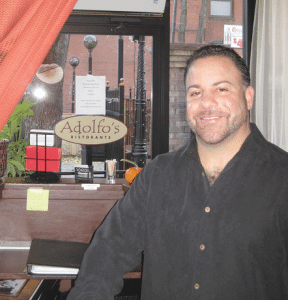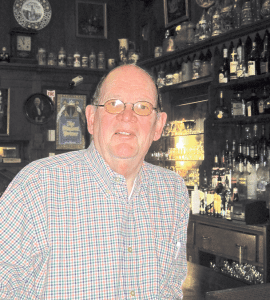Businesses Eye Potential in a Growing Over-65 Population

Don Anderson says older people enjoy cruises, but not necessarily the same ones younger travelers do.
At the turn of the century, just over a decade ago, the U.S. was home to 35 million people age 65 or older. Since then, the number has risen to almost 42 million — a nearly 20% increase — and the 65+ crowd in America is expected to soar to 79.7 million by 2040, according to the U.S. Census Bureau.
“All our health and science advances mean people are living longer,” Jason Harris said. “Many are healthy and don’t foresee any kind of health traumas, or maybe they’ve already had that hip-replacement surgery, and they look at that as a wake-up call — ‘we’re getting there, but we’re healthy … what if we live another 15 or 20 years? What will our quality of life be?’”
As founder and lead carpenter at Baystate Accessibility Remodelers, Harris takes that question seriously. His firm specializes in creating safe and accessible residential spaces for seniors and people recovering form injury or living with a disability.
The modifications run the gamut from bathroom fixes such as grab bars, modified toilet heights, and walk-in showers to widening doorways and building ramps and chair lifts for people using wheelchairs, all the way up to completely remodeling kitchens for wheelchair accessibility or building additions for in-law apartments so an older person can move back in with their children.
“Our job really runs the gamut from minor modifications to full-blown remodeling,” Harris said. “The Baby Boomer generation is a working generation, and a lot of them have assets, and a lot of them have over time invested in retirement and other things, including their homes. When they start getting into that age category, people might consider aging in place, rather than moving into institutional care. They own their home, and they want to put one more investment into their home and stay there because all the things important to them are around them.”
Harris’ company is just one example of a business that stands to benefit from the rapidly aging population. According to the monthly marketing report Selling to Seniors, people 50 and over control 77% of all financial assets in the U.S., own almost 50% of all credit cards, and account for more than 50% of discretionary spending power.
With that in mind, here are just a few of the kinds of businesses that stand to benefit from the proliferation of America’s golden-age population.
Living Well
Harris and his wife, Cindy (Baystate’s president), don’t cater only to the elderly with their home modifications; many times, their services help patients readjust to home life after an injury or disability.
“Many times we’re following the path of the occupational therapist or physical therapist who comes into the home when someone’s been in a rehab situation. They check the person’s medical history and come up with a roadmap and say, ‘these are the things they need,’ and when we get in there and do the home evaluation, we can talk to them and make sure we get the medical side of it, make sure we understand their issues,” Harris said.
But in many cases, customers are relatively healthy, yet recognize a coming need to upgrade their home to keep them safe living in it.
“They’re really looking at the value of what they could potentially invest into their home,” he told BusinessWest. “They’ve already made a commitment, and now they’re just saying, ‘this is just the next level of investing in the house.’”
Millions of seniors and their families struggle with the decision of whether to stay in their home or move to a residential-care setting, he noted.
“There’s a lot of expense that goes into moving into any kind of institution — whether they like that environment or not, there’s a lot of costs,” Harris said. “They need to decide whether the financial investment is something that’s possible, and also, do they want to move away from everything they’re comfortable with, or make some modification to their home? That’s what we have to consider to when we talk to potential clients; we understand that a lot of emotion goes into making that decision to stay home or move into an institution.”
For seniors who are healthy and ambulatory, the Boomers are known as a generation that wants to remain active, and they’re increasingly seeking out fitness and wellness options to help them stay in shape.
Take yoga, for instance. Karoun Charkoudian opened a yoga studio in Springfield in 2009 and will soon celebrate the one-year anniversary of her business, Karoun Yoga, in its new West Springfield location. From day one, she said, seniors have made up a solid percentage of her business.
“We’ve had a lot of retired folks in here, and definitely more and more seniors, especially for our gentle classes,” she told BusinessWest. “That’s definitely been the case.”
She said older people tend to enjoy yoga because it brings fitness benefits without a high impact on their joints. “It really helps alleviate a lot of arthritic pain and joint pain, that kind of thing. In my opinion, it’s a safer way to get stronger — and they definitely get stronger, and they work on their balance. It’s a better way for the senior population to do that.”
As general awareness of yoga continues to increase, Charkoudian said, studios like hers will continue to benefit from a growing older population.
“With our beginner class or gentler class, at that level it absolutely works,” she added. “It’s effective for all the benefits they’re looking for.”
All Aboard
The retirement years are often synonymous with travel, and today’s seniors have some specific ideas of where they want to visit. To hear Don Anderson, owner of the Cruise Store in East Longmeadow, tell it, they’re not flocking to Caribbean beaches.
“Certain types of trips lend themselves more to seniors,” he said. “For instance, on Alaskan cruises, typically much of the clientele — but certainly not all — are seniors. There’s more awareness of Alaska; it’s on people’s lists — ‘one day I want to see the glaciers, see Alaska, travel inland.’”
Another hot choice among senior clients are river cruises. “Older people don’t necessarily want the flashy, 2,000-ton cruise ships, but maybe something that handles 100 or 200 people, tops. They might want to spend overnights visiting the beaches of Normandy, overnights in Paris, Budapest, Prague,” Anderson said.
“Other big items on the bucket lists are national parks — and we were impacted by the government shutdown,” he continued. “Older people also want to travel overseas to Europe or Ireland, but don’t want to drive on the opposite side of the road and contend with that sort of stuff, so they like escorted trips.”
When seniors travel, they often do so alone or in pairs, but a growing trend involves larger groups and cross-generational travel — where older customers arrange to cruise with their children and, sometimes, their grandkids.
“They have disposable income, but their kids go where the jobs are, so the kids live in different parts of the country. So, as a coming-home type of event, they pick a cruise ship, which caters to different generations. They can spend quality time with their kids and kids’ spouses or significant others, and the ships have kids’ programs. Some seniors with disposable income put their money toward getting everyone together on board, doing things together, eating as a family together. We’re seeing an increase in that, with multi-generational trips initiated by the parent or grandparent.”
In any case, with family or not, “seniors are saying, ‘now is our time; now is the time to do it,’ and they like the idea of a company like ours, where we set it up but don’t charge service fees; they love that.”
But, like other types of businesses that cater to different generations, Anderson said, “you can’t sell the wrong product to the wrong people; certain trips lend themselves to certain clientele.”
As tens of millions of Baby Boomers sail into retirement, that bit of wisdom will continue to ring true.
Joseph Bednar can be reached at [email protected]













